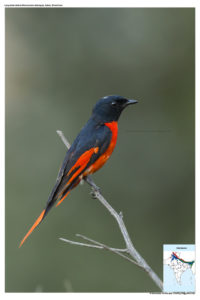
Long-tailed Minivet Pericrocotus ethologus
Etymology:
- Pericrocotus : Greek word for peri – very, all around; krokotos-golden-yellow derived from krokos- saffron
- Ethologus : Latin word for mimic derived from greek word ethologos –mimic
Vernacular Names: Hindi: Chhotapaharibulalchashm, Kash: Wozul mini, Pahari: Rajalal(M), Rani chara(F), Pun: Lampunjhisaheli, Cachar: Dao ribikashiba, Guj: Nanichanchvalorajala, Himachalirajalal, Mar: Lamb ShepatichaGomet
Distribution in India: Resident ofHimalayas and North EastIndia.
Description: Size of 19-20 cm.The male nominate race has head and upperparts to upper back black, glossed blue, lower back to upper tail-coverts scarlet; upper wing glossy black, greater coverts largely all scarlet, secondaries and tertials black, innermost 2–3 secondaries/outer tertials margined scarlet, inner primaries (P1-P7) with scarlet band across bases, longer on outer feathers, outermost primary edged pink-white; tertials narrowly edged whitish when fresh; tail relatively long, central two pairs of rectrices black, R2 with narrow red edge, outer four largely scarlet; upper throat dull black, lower throat and breast to under tail-coverts scarlet; underwing-coverts orange-chrome; iris dark brown; bill, legs and feet black. The female has narrow yellowish band on forehead and above dusky lores, narrow white eye ring, whitish cheeks, pale grey ear-coverts; greyish-olive upperparts, greyer on crown, with lower back to upper tail-coverts yellowish olive-green; red in wings replaced by yellow, but no yellow edges of tertials; red in tail replaced by yellow, with less colour on R2; chin and upper throat whitish, lower throat pale yellow, underparts yellow with faint olive wash.
Habitat:It is found in wide range of open forest types, including broadleaf and pine forests, light forest and forest edge.
Food Habits:It eats insects, including orthopterans, hymenopterans, beetles, flies and insect larvae, also spiders. Also eats buds of acacias and fruits. Forages chiefly in canopy; gleans, makes aerial sallies, and hovers in front of flowers.
Breeding Habits: They breed in April-June in India.Then nest is built by both sexes. The nest is a neat cup of grass stems, fine twigs, rootlets or moss, with cobweb and lichen on outside, attached to horizontal tree branch. They lay a clutch of 3-4 eggs. The incubation period is 11 days and fledging period is 12 days.The young are fed by both sexes.